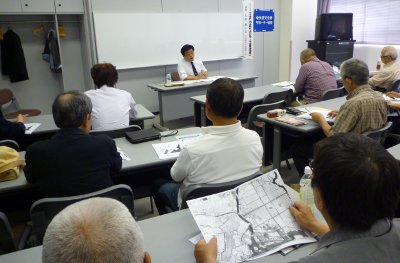Chuo-ku Easy History Lecture "Edo's Origin and Koto Region" was held on May 22 at the Municipal Women's Center "Bouquet 21" (photo). This is an open lecture designed to learn the history of Chuo-ku, and was organized by the Chuo-ku Cultural Properties Supporters Association, a town walking volunteer guide group.
 Lecturer is Takeo Kusome, Deputy Director of Nakagawa Funabansho Museum in Koto-ku. How to enjoy historical walks from the perspective of researchers in the early modern period (Edo period) is helpful.
Lecturer is Takeo Kusome, Deputy Director of Nakagawa Funabansho Museum in Koto-ku. How to enjoy historical walks from the perspective of researchers in the early modern period (Edo period) is helpful.
The Nihonbashi, Kyobashi, Hatchobori, Shinkawa areas, etc., which were the centers of Edo, were explained about how the town development of the capital, Edo, and how urban functions were developed by unraveling the formation of Edo from a geographical point of view. Was taken up and explained. From the early Edo period, along with the expansion of urban areas, the Fukagawa and Honjo areas in the eastern part of the Sumida River will also be developed.
In 1680 (1680), according to the pictorial map "Kasai Shi", "Genso Kiba" in Motozaimokucho (now Nihonbashi) burned out in a fire in Okemachi (now Yaesu-be) in 1641 (1641) was relocated to the Fukagawa River, along the Sumida River, along the banks of the Sumida River. What is interesting in this figure is the location where Tomioka Hachimangu Shrine was facing the seaside. The area near Kiba Station and Toyocho Station on the current Tokyo Metro Tozai Line seems to have been in the sea.
By learning about the history of Chuo-ku from the surrounding area again, I was reminded of the depth and spread of Edo, a city built over 265 years. @ Akira Makibuchi

